Thrifty Shopping for Home Décor
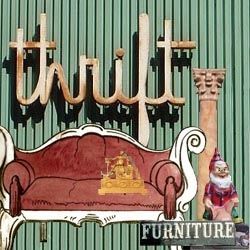
How to Spend Less for More Decorating Style
Who needs money?
(Okay me too.) But really, why? Not for home décor. Admittedly, if you want to decorate in the gold-plated Rothschild style then, yes, cash is required, but for ordinary-mortal decorating, for stylish, beautiful, comfortable interior design of your home - whatever your favorite style - you can do very nicely, thank you, on the cheap.
Design for less. Style on a budget. Thrifty décor.
Where should you be shopping? There's no one answer - it depends on where you live and what's locally available - but generally your best shopping grounds will be either:
1) up-scale stores under special conditions
2) discount stores of various kinds
3) specialized suppliers
4) dealers in used goods
5) person to person sales
We'll discuss some other aspects of budget decorating (like paint, the Cheap Decorator's best friend), but this article will mainly talk about thrifty shopping as a key to creating a beautiful environment for a beautiful price.
Me? I design theater sets.
I know how to create a good room on a tight budget!

Here's an example: a living / dining / kitchen built on-stage for the play Rabbit Hole.
Everything you see - including the walls and faux stone fireplace - cost only a few hundreds. Admittedly there were some borrowings in there that helped keep that cost down, but major pieces like the sofa were bought, so we didn't cheat too much. Shopping was an intense 2-3 weeks and ranged everywhere from odd off-price furniture stores to IKEA to many thrift and dollar stores.
Note that the style is NOT "shabby chic," but a simple contemporary style, with attention to texture, but little color. Using more color, more eccentricity, or reveling in the "shabby" part would only make decorating easier and cheaper.
(Mind you, I like "shabby chic," but it's presently In-Style which means it will shortly fall out of style. Personally, I aim for less trendy, more timeless. It lasts longer!)

And on the right here is another incredible cheap yet rich-looking set.
This is meant to represent the Manhattan penthouse apartment of a world famous architect... on a budget of, again, a few hundred dollars. (No pressure, no pressure.) Now, as a real-life room we sorta cheated because there are lots of borrowings, but, in real-life, all of this furniture could have been bought at huge discount because they were warehouse white elephants. Find the right clearance sales and you could find similar bargains!
Cheats you could match at home? Those rich wood-look walls are built of cheap Masonite panels left as-is. The rug could be something a friend is storing, unused and the floor is simply painted. The huge modern art? We made it from foam. All those wonderful bookshelves were borrowed, but were very plain easy-to-build units made from pine planks that we stained in an afternoon.

Where to Start?
First stop on your budget furnishing quest is your own attitude: Are you feeling mildly schizophrenic today? It helps. Because you need to be - at one and the same time:
1) very sure of what you want, and yet simultaneously,
2) open to unexpected possibilities.
This is BARGAIN SHOPPING!
As best you can, understand your own style and color preferences and your design goals for your space. "Know thyself," turns out to be decorating advice. Keep in mind that the more specific (and unpopular) your preferences, the harder they will be to find. That unpopularity will either make your finds more expensive to buy - or much cheaper.
At all times it's wise to carry color samples you need to match, a tape measure, and a notebook with critical dimensions, like window sizes, jotted down in it. Know exactly what size a desired piece of furniture must be to work for you and what functions it needs to perform.
For instance, if you need a dining room storage piece, must it have drawers? doors? should those be glass? would open shelves do?
The more flexible you can be in answering these sorts of questions, the wider your choice of possible solutions. The same goes for color: is only one shade of wood acceptable or would a range of woods or painted finishes work? Finishes can change! But it's a lot easier to repaint something than to strip and refinish natural wood.
Ditto on upholstery - reupholstry can be terribly expensive and most amateur work looks... well amateurish. Know the limits of your skills and pocketbook.
CAUTION: there is an outbreak of bedbugs at present, especially on the U.S. east coast, so be Very Wary of adopting used, especially upholstered furniture. Hesitate to bring home that cast-off squishy armchair waiting for the trash! Always remember that this stuff is USED... who knows how? (Be equally cautious of bug sprays... one woman recently used 18 cans of fogger... and exterminated herself!)
So. Can you clean it well enough? What germs or hazards could this cool find hide? Be especially cautious about anything that may come in contact with children, pets, the ill, or the elderly since older goods may not meet current safety standards. For germ-phobic reasons, I hesitate to buy used plastics - never buy it for FOOD use. But with any material, remember that decorative use is one thing, use with food is another: even modern pottery or crystal can leak lead, for instance, into an acidic food or drink if that bowl wasn't intended for food use.
I don't mean to scare you, but this IS shopping with the training wheels off... Caution is good.
Books on Budget Decorating
Here are books just bursting-full of good ideas for budget decorating.
Naturally, they run heavy on the shabby chic style. But do keep in mind, it's EASIER to go for the shabby chic look, but that's not the only style you can create while buying on the cheap, eh? If you look long enough and widely enough, have a good eye and some luck, you can furnish cheaply in any style.


On-Line
Since we're here on-line, I'll assume we both know about many of the possible sites for buying at a discount through the computer: eBay, Etsy, Craig's List etc. being the classics. ("Classic" on-line being defined as "older than two weeks.").
eBay, in particular, used to be a great source of bargains; nowadays it mostly sets the market price for collectibles and it's Craig's List that might hide a bargain... usually on some piece of furnishing too bulky or heavy to be easily shipped. If you have access to a truck, your selection improves!
Etsy and similar art and craft sites, where you buy direct from the artist, can be a wonderful source for unique and often inexpensive art or decorative items. I've had good luck with Etsy and gotten great prices on well-crafted, beautiful art prints (and jewelry - a different article).
Another attractive site is Fab, which carries mostly contemporary and modern furnishings, often at a good price.
As with any other time you dealing with folks you don't know - use caution. Protect personal information and, if you meet a stranger, take sensible precautions. Always check a dealer's reputation before agreeing to a transaction.
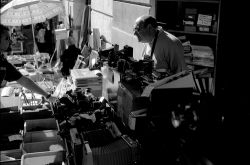
Flea Markets
From the high-tech modern on-line world to the
old-world, low-tech street or "flea" market...
I'm defining Flea Markets as any street market... Expect more fleas and better bargains at the trashier looking ones. The quality of a flea market can vary tremendously - from the world-famous Paris antique market, to the regionally famous antique market in Canton, Texas, to your locally infamous honest-it-fell-off-the-truck! single pick-up at the abandoned corner gas station.
At any of these, it's Buyer Beware. Most of these dealers are honest folk, but even they sometimes close up shop due to the vagaries of Mom-n-Pop business life, so their stand may not be there when you go back. Remember that most flea market sales are keepers - no refunds, no returns, strictly as-is condition, provenance often unknown.
For the budget home décor shopper, the most fertile markets tend to be the ones with antiques, collectibles AND downright junk. It's in the murky area between collectible and junk that you find the most bargains... with occasional great deals on the serious stuff.
A closely related type of sale is the CAR-BOOT SALE popular in Britain which sounds (from what I hear) like a flea market with car trunks as the stalls.
A Guide to Flea Markets
This is the most helpful book I've found on the topic, very clear and full of good hints, with even a section on etiquette! Well worth owning.

Flea Market Style

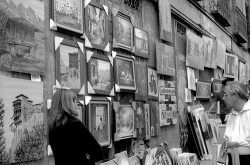
Art and Craft Fairs
Etsy is just the virtual equivalent to real life art and craft fairs.
Fairs are well worth visiting, partly because it's a wonderful way to spend a nice afternoon, wandering between tents full of colors and shapes and amazing objects, and partly because you can find a good selection of very fairly priced arts and crafts for your home. Some pieces will be waaaay out of your budget, but there are always inexpensive - but "real" art! - prints and photographs.
If you find a good local art fair... it will usually reappear next year at the same season, giving you a chance to develop favorites, to revisit booth to see that artist's work develop, perhaps even to begin following or collecting their work. A fascinating hobby.
The best selection will always be during the first day and hours of any fair - just as at an antique show - but the best deals can happen at the end of the fair when artists might prefer to sell a piece rather than to pack it up. You can hope.
It's wise to set a budget before you go. And, unless a piece is unique and you'd be crushed if it sold to someone else, I suggest spotting what you want, but walking around before buying it... to cool down any crazy buying fever and to check if there is something else you end up liking better.

Art Galleries and Such-Like
Sadly, fancy art galleries are usually too expensive for the budget decorator to buy much from... but there are unpretentious galleries and art and craft fairs, as well as the chance to buy direct from an artist or to find art in thrift stores or even more unexpected places. There can be hidden bargains.
(Here's my best thrift store find: at a nasty, boil-your-hands-dirty thrift store, looking for frames. Flip, flip, flip through their stock, when... wait... what was that? Flip back a few frames. A black and white image of a man on horseback. An etching by Salvador Dali! I got it for less than $ 5. Better still, it's beautiful. So keep your eyes open.)
Here are a few rules of thumb on art pricing: any art form that is reproduced - consists of multiples like posters or prints - is by its nature going to be (comparatively) more reasonably priced than a one-off object like an oil painting or carved statue. Works on paper tend to be less costly than ones of, say, marble. Art by un-famous artists is hugely cheaper than even inferior work by famous ones, and out-of-style styles will be underpriced... right until they come back into fashion. Then they get over-priced!
Art museums offer copies of images from their collections as posters, post cards, and such - an inexpensive way to "collect" fine art. (Sometimes you just want that Monet waterlily you could never, ever buy for real.) Whether you want to collect fine art or simply want to include some pretty images in your decorating, you need to give thought to both what you like and the state of your budget. It's always possible to hit a discount chain and cheaply buy something "decorative" for your wall, but I'd like to make an impassioned plea for buying "real" art.
By "real" art I mean pieces, of whatever kind, that a fellow human put real thought and skill into making. But I'm not snobby: "real" art could be an oil painting, but it could also be a striking piece of mass produced graphic design like an album cover, an advertisement, or a band's flyer. If it pleases you, almost anything can be serve as art - a rusty gear, a weathered wooden object, a water-washed stone... Find beauty or meaning.
The great blessing for thrifty art lovers is that beauty is surprisingly often... free.
When you DO have cash for art - support an artist! Buy art from a dealer or the artist themselves
Books on Collecting Art - (On the Cheap)
Who says only the rich get to enjoy art? Who says artists have to starve?
Go and buy real art!
I think the secret to buying art is to NOT think of it as investing... Buy things you love to look at. Maybe, over time, you might concentrate on particular types of art or artists and collect seriously - with some idea that your collection might become worth more. But that's just a side effect of collecting what you love. Art adds a lot to daily life.
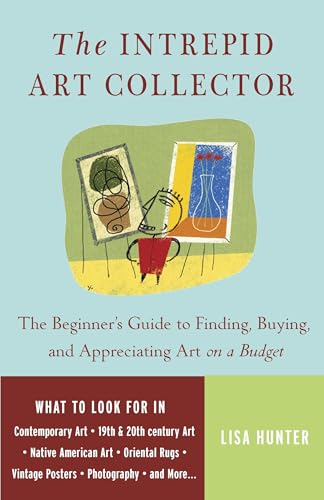
Fine Art on eBay
Let's see what eBay is offering today...
Save $
Frame your art yourself.
It's Not That Hard DIY Picture Frames
Ready-made frames can be expensive, but often go on sale (check Hobby Lobby!), and are available at discount and thrift stores. Thrift stores are a great source for a single sometimes beautiful frame. IKEA is a good source for plain frames, especially if you need several that match. And dollar stores can be sources for frames when you need many smallish matching ones - the hard part is finding simple (non-ugly) designs; then buy twenty! Replace their "art" with yours. This works at big box stores too - it's often cheaper to by bad art with good frames than empty frames.
Obviously very cheap thrift store frames will not have beautiful wood or carving - are probably nasty plastic - but paint them all black or white or nursery-color and it hardly matters. If you're framing contemporary art, paint them glossy red!
What stymies many decorators from framing art themselves is matting - how to cut the mat? But it's not such a problem. Either:
1) buy pre-cut mats, usually white or cream
2) ask the staff at the frame or hobby shop to cut you a mat to fit your art and cheap frame, or
3) DON'T mat the print, just float it on a background of mat board (voila! no cutting, at least none not hidden by the frame itself)
There are other options, like unusual materials (why not thin paper you CAN comfortably cut?) or sandwiching the print between the glass "framelessly" (store-boughten kit or rigged up from glass and plate hanging gizmos).
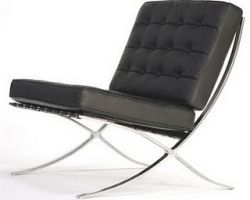
Sales
One of the best ways to buy exactly what you want in the way of furnishings is to find it at the expensive place... then wait until it goes on sale.
If we're talking about high-end furniture or lighting, the sale price may still be a real stretch to afford (25% off of "Insane" is still "mildly-crazy"), but for a very special, much-coveted piece that might be worthwhile. Some of these stores have yearly or bi-yearly sales that may cut their usual prices dramatically. And some of the fancy stores have off-price outlets where you can get a better deal year-round.
Many of the most delux furnishings are still only available through "To The Trade" showrooms which won't let ordinary buyers in without an interior designer or an architect as an escort . If you have any designer friends, ask them to handle the purchase for you for free. If you don't, you could approach an interior designer and explain courteously, right up front, that all you want is for them to handle the purchase of item X for a minimal fee: they may agree. No bargain here and, again, such "To the Trade" items are VERY EXPENSIVE, so you'd have to really really want it.
Many of these showrooms - like Knoll with it's classic modernist furniture - do have a yearly sale for designers. (Designers can't afford the stuff either!) The modern furniture store Design Within Reach (which is, it turns out, named for its policy of letting buyers in without designer escort, rather than for its particularly low prices) has a summer yard sale.

Big Box - Off Price
You know these stores, the ones that sell quantities of new goods that, for some reason, didn't sell well elsewhere - over-runs, unpopular, over-ordered or discontinued models - or that sell items in such bulk (or so designed) that prices are rock-bottom. Among them are Big Lots, Tuesday Morning, Garden Ridge, and Ross Dress for Less (also Accessorize for Less!). Make a habit of looking for home furnishings at what are primarily other kinds of stores: clothing, garden, fabric, or craft stores. Price and value can be surprising. (Good surprise or bad!)
Off-price box stores can be good places to find originally expensive goods at much reduced prices. Depending on your taste and what you're hunting, you can sometimes find one lonely fabulous object that no one else understands... that you love... at a great deal.
The reigning king of low-cost big box stores is the Great Big BLUE Box of IKEA. Here the low price is designed into the product at its birth by very clever designers. Breakdown for easier, cheaper shipping and customer home assembly are part of this store's ethos. It gives you, the buyer, real value for your money. IKEA designs are always reasonably priced, well thought out, and handsome looking in a mildly Scandinavian and often, but not always, Modern style.

Factory Outlet Stores
Since "Outlet Malls" got popular, a lot of stores use the "outlet" word without being what I'd call a real factory outlet... originally a rare (one per factory!) store to sell greatly discounted over-runs, slightly imperfect, or otherwise unshippable goods. Nowadays it usually just means last season's at some discount. Still a savings.
Frankly, I've never found particularly terrific deals on anything I really wanted, but you might, especially if you're looking for china or kitchenware.
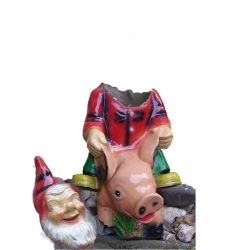
Scratch and Dent
Now here is where the diligent thrift shopper can really save! Almost any store has a Bargain Bin - a shelf or corner where floor models or damaged goods are sold at a reduced price. You'll soon figure out which places barely mark down merchandise (however badly wounded!) and which price to move.
Carefully study the wear on a floor model or the damage and decide whether it truly matters to you or it effects performance. On appliances, for instance, a shallow dent in the side of a washing machine... who's ever going to see it? These sales are AS IS. This is when your preparations - measurements, color samples, etc. - help you, because these deals are one-off and snatched up fast. You have to decide on the spot and, if you want it, buy it immediately.
Sears has a few special stores around the country for damaged appliances - if you live near one, you can find great deals. Every IKEA store has an area near checkout with discounted or damaged goods. Hobby Lobby can have reductions of 90% on end of season, damaged items. (Many still overpriced - what good a garden gnome with no head? Unless you happen to need a garden gnome with no head.) Closely related is the Oops! paint shelf at most home centers or paint stores, where someone's mistake might be your living room wall...
at half price.
Save $
Embrace the imperfect.
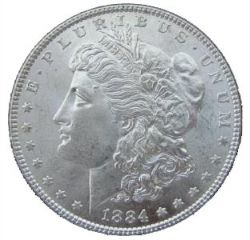
Dollar Stores
I tend to avoid these... To my mind much of the merchandise isn't worth even that dollar. NEVER buy a dollar store screwdriver, for instance, because its cheap metal tip is softer than the screws it tries to turn! Be sure to go into a dollar store knowing the usual price elsewhere for the item you're hunting... I've seen dollar stores mark things UP to that dollar.
But you can sometimes find good looking glassware or other household objects and these are good sources for those simple straw beach mats, which can make good wall-covering.
I have the best luck in finding unusual things at Mom-n-Pop dollar stores, rather than the chains.
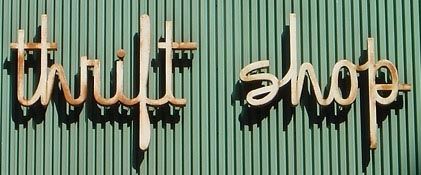
Thrift Stores provide rich pickings and good deals for thrifty home decorators.

Thrift Stores
Addictively fun playgrounds for the value shopper.
The trick is to discover the best thrift stores in your area for the type of goods you want (many only carry clothes or only trashy furniture), then return often. DEALS SELL FAST. Thrift store shopping is
See It / Buy It shopping - things can sell while you stand there making up your mind, so you must be prepared and ready to pounce.
At the same time, you need to simply stroll, with no particular goal, and just see what you see. This, for me, is the most fun... that strolling survey just to take in today's catch and discover, perhaps, a Dali print, an Italian Deruta plate, a '60s flower pot, or a strange steampunk clock.
The obvious danger to thrift shopping is that you will feel a need to "rescue" some object that deserves better than this fate... that deserves a loving home... whether you need it or not! I suspect a lot of antique and collectible dealers start out this way.
Oh! And remember that thrift stores usually benefit good causes, so please buy FROM them, but also remember to donate gently used clothing and household goods TO them. Here's an opportunity to volunteer your time as well.
Save $
Visit a thrift store every day.
Links on Thrift Store Shopping
There is definitely a learning curve in starting to thrift shop. Really looking hard at the merchandise, for one thing, since everything is sold As Is. Here are some other sites that offer hints.
- Happy Money Saver - Thrifty Tips
Good advice on thrift store shopping, like "Try Before You Buy!" - A Basic Guide to Thrift Store Shopping
From lifehack.org some good (and good karma) rules of thumb for shopping at thrift stores. - 12 Tips for Thrift Store Shopping
Simple Mom advice on thrift store shopping. - Funky Junky Decorating
A good shabby-chic-ish Lens with a MUST READ list of safety tips for buying used good. - Thrift Store Junkie
A thrift store fan's page - especially good on thrift clothes
Books on Thrift Store Shopping
Guide books to the world of decorating from thrift stores.
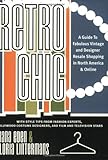

Charity
Thrift stores are often run by or for charities.
There are also some specifically home-builder stores that raise money for charity, like the Habitat for Humanity stores which sell donated building supplies, lighting, hardware, or doors etc. at reduced prices, with profits supporting their home building program. This is a great first place to look for lighting fixtures since often have good deals on brand-new styles - and you know your purchase helps support good works.
Consignment Stores
Occasional good deals, but largely over-priced, I think. The folks putting their castoffs in the consignment store often have an optimistic idea of its worth and are in a get-rich! kind of mood. Then again, there can be bargains. You just have to look and keep looking. But you'll soon learn which stores are overly proud of their merchandise and which convince their consignees to be reasonable in pricing.
A sub-section of consignment stores are the ones that specialize in estate sale pieces... the things that didn't sell at the house, but are often beautiful pieces that just need the right buyer.

Liquidators
Hotel, restaurant, and office liquidators are great sources for sturdy, good quality beds, tables, chairs, and desks at sometimes incredible prices. Office liquidators have many pieces of furniture suitable for a home office. Restaurant liquidators sell used tables and chairs plus some serving pieces and buffets etc. Think about all the furniture in a hotel: beds and bedroom furniture, of course, but also desks and desk chairs, lobby furniture, sometimes even pool and patio furniture...
If you happen to be looking for an amoire or a cabinet in which to hide a home office, a hotel liquidator will have hundreds! of cabinets that used to hold old deep-style TVs... priced to sell. Wish I needed one because the bargains are amazing.

Specialty Suppliers
Restaurant supply companies, for instance, can be great sources for reasonably priced - and very durable! - kitchen and dining gear. Find a company that supplies, say, Japanese restaurants and you may also find all sorts of interesting decorative goods too, like those beautifully graphic Japanese fabric doorway curtains called noren or those happy, waving Lucky Cats.
Noren from Amazon
These Japanese door curtains are beautiful and often very graphic. What a nice way to add a little more separation between spaces, when you don't really want to close a door.
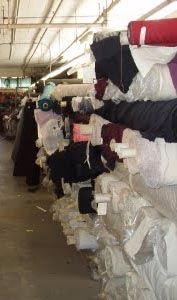
Fabric Outlets
Fun, fun, fun! And you can - if you find the right place - discover beautiful upholstery fabric for as low as 2 $/yd. (Get on your favorite place's mailing list - the yearly Super Sale may make that 99 cents a yard.)
Most towns have some sort of fabric store and these generally run frequent sales, but what you really want is a great big barn of a discount fabric warehouse where you can find remnants, the ends of bolts, and over-run fabrics. The best places are often wholesale/retail places...
These joints may have funny rules like minimum purchases or no credit cards.
Save $
Buy discount fabrics.
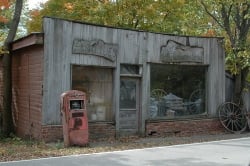
Antique (Junk) Stores
The junkier the shop the better the prices... unless they just want you to think that. Whenever you shop for antiques or collectibles, you need to have a feeling for market prices and a nose for the real versus the erzatz. While there can be deals there can also be rip-offs. If you get to know the folks at your favorite store, you can sometimes bargain the price down.
Ye Olde Anitque-y Junque shops can be entrancing places to shop, with some very good deals. Another visit-often sort of shop, since stock changes constantly and it's one of a kind merchandise.
Books on Buying Budget Antiques
Advice from experts.
Estate Sales
A little sad, these sales when someone downsizes their home or an estate is liquidated - some buyers just can't cope with the feeling of mortality. But the deals can be lively. Depending on the estate, there may be very beautiful furnishings selling for very reasonable prices and sometimes, if the item is unpopular or bulky, for very low prices.
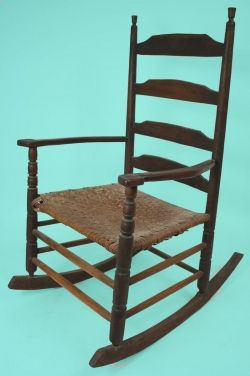
Family
NEW Section
How did I forget this GREAT source for FREE furniture?
See if your grandparents, parents,or siblings have any furniture or decorative items in their attics or garages they are willing to loan or give you.
Family furniture is usually free (can't get thriftier than that!). Often family hand-me-downs are useful, basic pieces that a lick of paint can refresh. Sometimes - if you wisely choose a wealthier relative - castoffs may be better than you can afford. Sometimes family pieces are old enough to qualify as "retro" (a charm your granny will usually be oblivious to), or more rarely, may be an heirloom with sentimental and historic value. Rockers that once rocked your parents as babies can rock your own newer babies: that's pretty special.
So ask around. Someone may give you a hand-made quilt or a '20s cabinet. But be sure - ask explicitly! - whether this furniture is a gift or a loan. Know whether you are the newest steward of a family treasure or just taking junk off someone's hands before you paint it!
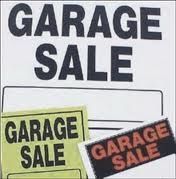
Yard and Garage Sales
Most of us have done a little garage sale shopping - or thrown a few sales ourselves. These sales generally fall into two camps: the over-priced and the under-priced. Look for the latter!
A reader reminded me that you can get bigger bargains if you visit late in the day, at the end of the sale. Always try to dicker! And this reminded me that, if you want the greatest selection, you want to visit right as the sale opens... so maybe visit twice?
The Guide Book to Garage Sale Décor
I haven't gotten hold of this book yet, but it looks like EXACTLY the book we all need before launching ourselves out into the untamed yards and garages of the world.
I feel comfortable on the fix-it front and am good at spotting treasures, but since I've only done a modest amount of garage-sale-ing... a little advice on bargaining would help me. How about you?
Salvage Yards
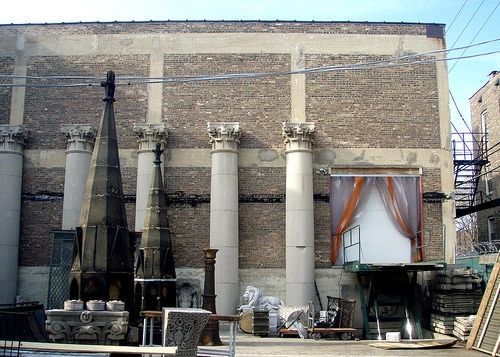
Photo courtesy of Sharala at Blogaway

Salvage Yards
Architectural wrecking yards are tremendous fun and can be very useful to the home remodeler or decorator.
These places sell the rescued remains from wrecked buildings - both local and, sometimes, imported from castles in Europe or wherever. Prices tend to be high to crazy-high, but the humbler salvage yards can have good deals, especially on the less showy pieces.

Curb Trawling and Dumpster Diving
The title says it all: what treasure can you rescue from the curb - before the trash guys get it?
This May Be Illegal in Some Areas. Find out before you try.
The other caution is that furniture can be infested with pretty nasty insects (bedbug infestation?) or may harbor weird smells. Even for the theater, I stay away from upholstered goods. But a nice solid wood chair that just needs a little glue? Might be worthwhile. The concrete garden nymph was a fantastic find!
(Most recently I found a weathered cast-off swimming pool life ring - I wouldn't trust it with my life, but it'll look great on stage.)
By One of the Leading Decorators
With all her professional experience... Design on the cheap!
I own several books by this writer/designer and have always found her advice useful. (And the pictures inspiring.)

















